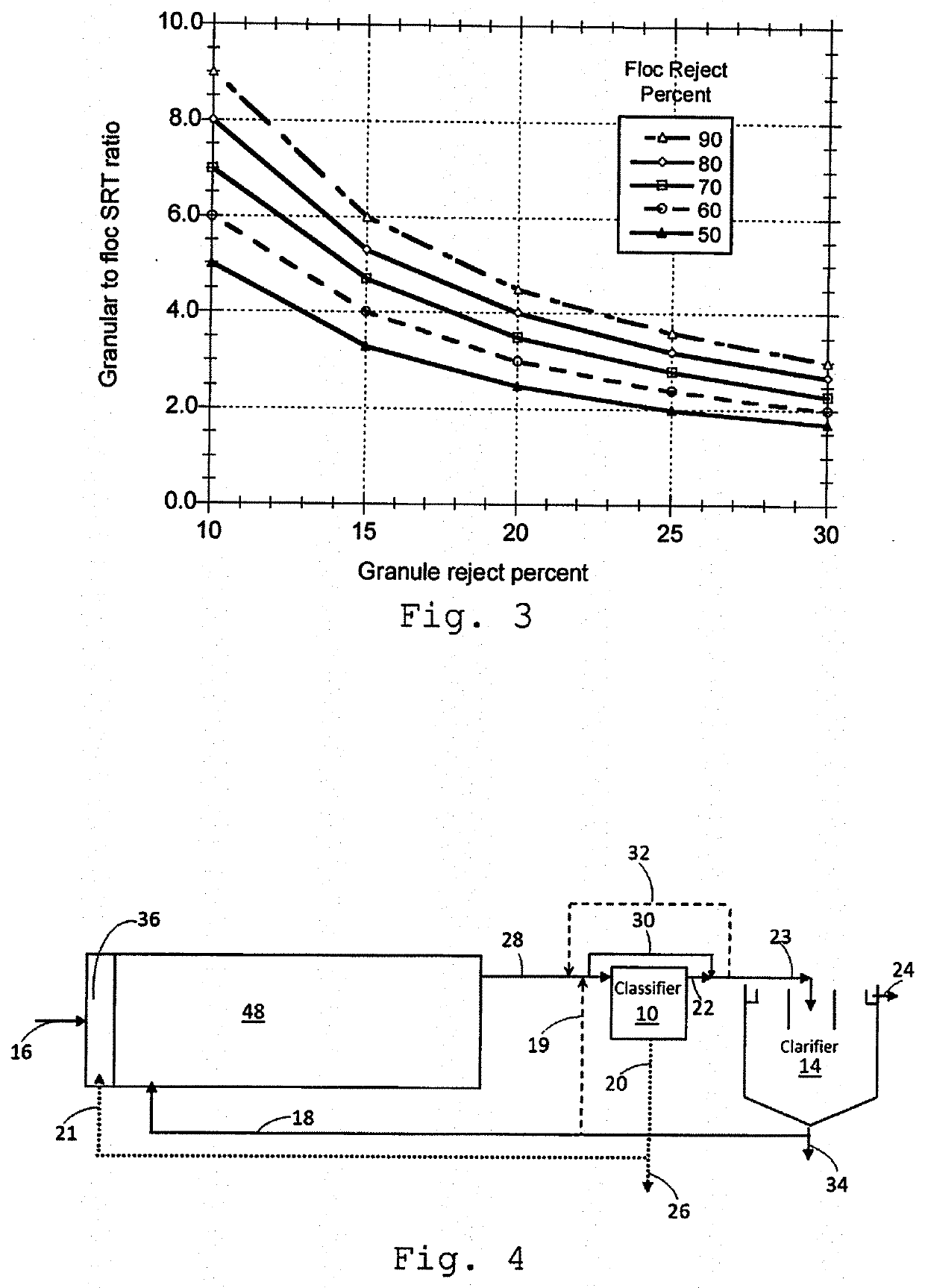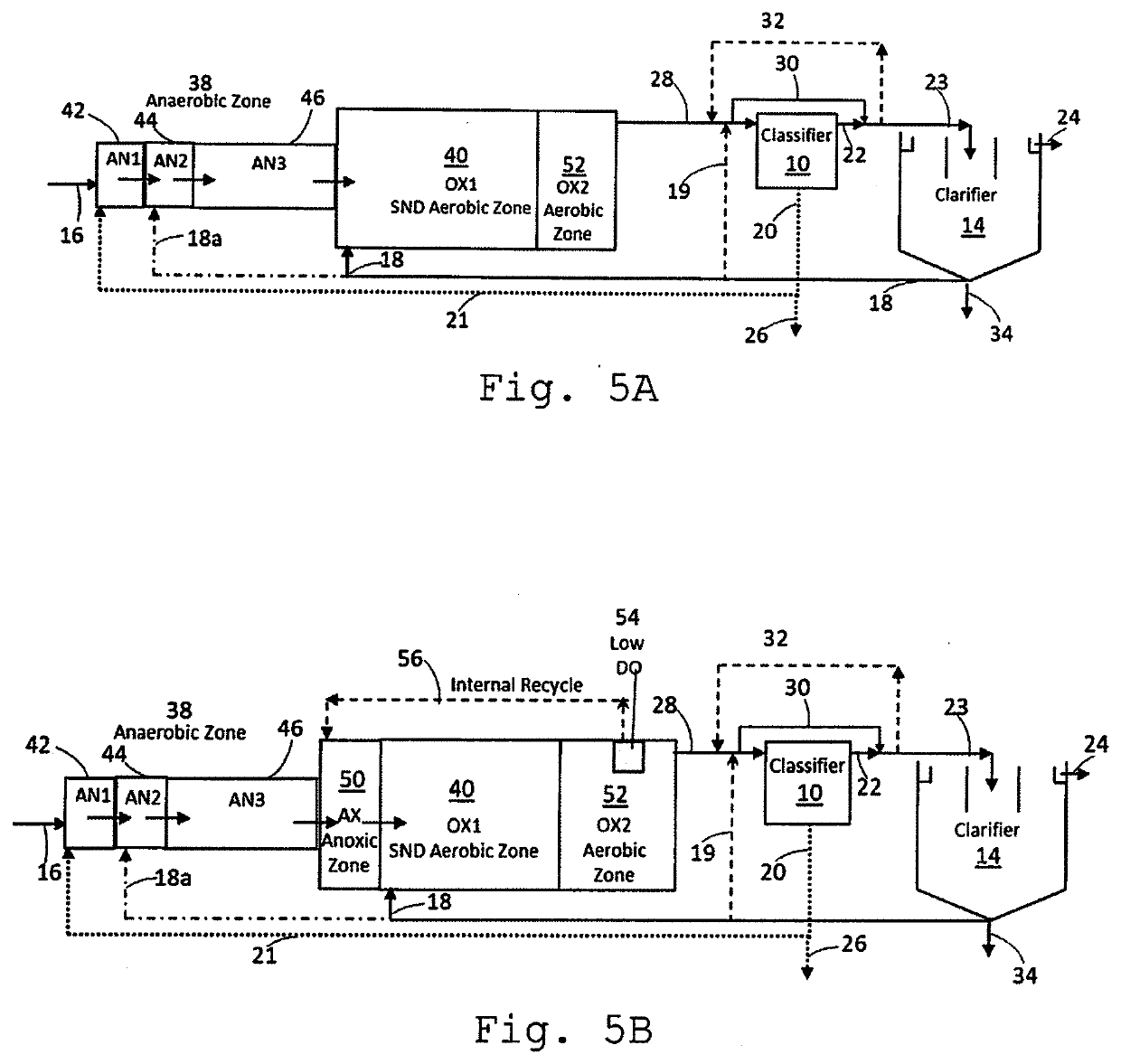Biomass selection and control for continuous flow granular/flocculent activated sludge processes
a technology of granular sludge and sludge, which is applied in the direction of biological sludge treatment, biological water/sewage treatment, oxidation of sludge, etc., can solve the problems of difficult conversion of existing continuously-fed systems to sbr systems for granular sludge selection, inability to address relative, and inability to achieve economic attractiveness, etc., to achieve acceptable and good performance, the effect of assessing the efficiency of the classifier
- Summary
- Abstract
- Description
- Claims
- Application Information
AI Technical Summary
Benefits of technology
Problems solved by technology
Method used
Image
Examples
first embodiment
[0077]The first embodiment shown in FIG. 5A is a continuous flow combined granule / flocculent sludge process to grow granules with PAOs and to allow SND to achieve for both biological nitrogen and phosphorus removal. The process has an anaerobic zone 38, an aerobic zone with SND 40, a final aerobic zone at higher DO 52, granular sludge classifier 10, and a secondary clarifier 14.
[0078]Granular sludge is recycled from the classifier line 21 to an anaerobic reactor 42 with a volume that result in a high soluble bCOD loading from the influent flow line 16. The anaerobic zone may have at least 3 stages (3 mixed reactors in series) with the first reactor at a high soluble bCOD loading of greater than 4.8 g soluble bCOD / L-day and less than 30 g soluble bCOD / L-day. The 2nd stage volume 44 is at least as large as the 1st stage and preferably no more than double. The 3rd stage 46 is much larger and can exist as a single tank or be divided into multiple stages. The high soluble bCOD loading as...
embodiment 1
[0084]A modification to Embodiment 1 for wastewater with a low influent soluble bCOD relative to the influent total organic and ammonia nitrogen is shown in FIG. 5B. The modification relies on the degradation of particulate and colloidal solids to provide degradable COD for denitrification. This process contains an anaerobic zone 38 anoxic zone 50, a SND aerobic zone 40, a second aerobic zone 52, a low DO zone 54, a granular sludge classifier 10, and a secondary clarifier 14.
[0085]This process is necessary for applications lacking enough soluble bCOD to enable high removal of nitrogen by SND with PAO granular sludge. Due to the low soluble bCOD:N ratio the amount of stored carbon by PAOs in the anaerobic zone cannot provide enough electron donor to consume a high percentage of the amount of NO3 / NO2 produced in the aerobic zone. An internal recycle flow, line 56, from the low DO zone 54 within the second aerobic zone 52 provides NO3 / NO2 to the unaerated mixed anoxic zone 50 for consu...
embodiment 3
[0098 shown in FIG. 9 is for a continuous flow combined granular / flocculent sludge process for nitrogen removal where phosphorus removal is not needed. No anaerobic zone is used in this case and the granules grown are based on the classifier operation and the soluble bCOD loading to the first stage reactor 54 of the anoxic zone 50. The process contains an anoxic zone 50, an aerobic zone 40, a granular sludge classifier 10 and secondary clarifier 14. The second anoxic reactor 58 may be single stage or divided into two or more stages. The aerobic zone 40 may also be single stage or divided into two or more stages.
[0099]All the features and operational conditions described for the classifier and clarifier and sludge management are applicable and clarifier operation described in Embodiment 1 above with FIG. 5A are included.
[0100]FIGS. 10A through 10D show an energy dissipating inlet (EDI) 110 that can be used in the preferred classifier shown in FIG. 6B. This is sometimes called a rever...
PUM
| Property | Measurement | Unit |
|---|---|---|
| concentration | aaaaa | aaaaa |
| concentration | aaaaa | aaaaa |
| concentration | aaaaa | aaaaa |
Abstract
Description
Claims
Application Information
 Login to View More
Login to View More - R&D
- Intellectual Property
- Life Sciences
- Materials
- Tech Scout
- Unparalleled Data Quality
- Higher Quality Content
- 60% Fewer Hallucinations
Browse by: Latest US Patents, China's latest patents, Technical Efficacy Thesaurus, Application Domain, Technology Topic, Popular Technical Reports.
© 2025 PatSnap. All rights reserved.Legal|Privacy policy|Modern Slavery Act Transparency Statement|Sitemap|About US| Contact US: help@patsnap.com



